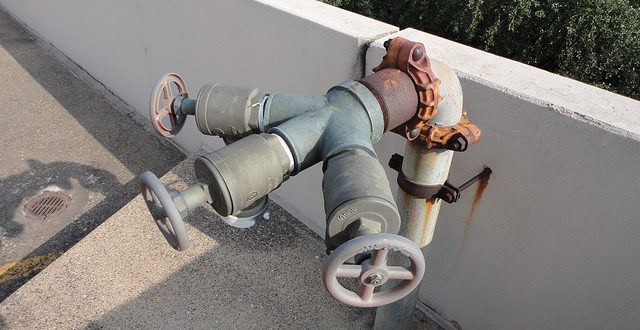Seeking Solutions in NFPA 25 to Unusual Challenges
Inspection, testing and maintenance service providers face many challenges, which we in the “training community” often espouse in articles and live seminars. All too often, we focus on the obvious issues associated with liability, contractual structure and responsibilities to meet requirements of NFPA 25, Standard for the Inspection, Testing, and Maintenance of Water-Based Fire Protection Systems. Recently, I was challenged by a member who said something along the lines of, “Stop telling me what not to do and start helping me understand how to accomplish some of the specific tasks at hand.”
When I asked what the specific problem was, he told me his current dilemma was related to flow testing standpipes, which NFPA 25, 2014 edition section 6.3.1.1.1 requires every five years. I was a little confused at what appeared to be a simple challenge so I relied on my ability to recite the aforementioned section from memory. I said, “It’s simple – the standard requires you to verify the required flow and pressure available at the most hydraulically remote hose valve outlets while flowing the standpipe demand.”
I followed that verbal regurgitation of the code requirement with a smile and added the requirement is to flow 250 gpm from each of the top two fire hose connections (for a total of 500 gpm) from the furthest standpipe at 100 psi for newer buildings or at 65 psi if the building is older than that requirement. Additionally, you need to flow 250 gpm from the top of each additional standpipe up to a total of 1,000 gpm for a sprinklered building and 1250 gpm (max) for a non-sprinklered building. I was feeling pretty good at this point for being able to provide accurate and immediate guidance right out of the standard until the member responded by saying, “I know how to read, Bob, but how do we physically accomplish this task?”
Well, I started to explain how back when I was a contractor, we would take two 2.5-in. fire hoses up onto the roof and connect them to the fire hose valves and flow them using UL play pipes or Hose Monsters up on the roof. I went just a bit further to put a nail in the answer by stating he should use the tables provided in NFPA 291, Recommended Practice for Fire Flow Testing and Marking of Hydrants, to convert the velocity pressure into gpm flow, or he could just use the formula, which I rattled off from memory: Q = 29.84 x c x d2 x √p. I continued to explain that often times, we were required to close a downtown street and flow off the rooftop in the pre-dawn hours and sometimes we even had to have the police on site to shut down the street.
My smile went away again when he told me he wasn’t permitted to flow onto or off of the rooftop and was actually looking for an alternate methodology to perform the test. Ahhh, now I understand the challenge! We need a solution to an unusual problem – something out of the normal condition – something that doesn’t fit neatly into the box.
Well, the next obvious answer was to show him the next section (6.3.1.1.1), which provides the best answer. It states that where a flow test of the hydraulically most remote outlet(s) is not practical, the Authority Having Jurisdiction (AHJ) shall be consulted for the appropriate location for the test. This seemed simple enough… we’re off the hook for a solution, right? It’s the AHJ’s problem to tell us what they want. WRONG! The AHJ kicked it back to the contractor and said they needed to provide suggestions, so we’re back to square one.
So let’s break this down to a few obvious and simple solutions until we find the most practical approach that is safe, cost-effective and acceptable to accomplish the objective at hand, which is to ensure adequate flow and pressure where required.
When discussing any site-specific problem, I like to consider the obvious and in the case of sprinklered buildings, it’s obvious that where the sprinkler system works as intended, the standpipe system is really a back up, which will hopefully only be needed for mop-up operations. Realistically, most high-rise buildings are light hazard or residential occupancies (at least on the higher floors) so the sprinkler demand will most often be less than the standpipe demand – and we are not required to add the two demands by either design standard (NFPA 13, Standard for the Installation of Sprinkler Systems, and/or NFPA 14, Standard for the Installation of Standpipe and Hose Systems).
For all practical purposes, the standpipe system in a vertical hydrant system which is provided in large and/or tall buildings because it’s not practical to drive the fire engine into the elevator and push the button for an upper floor. Rather, we have to fight the fire and, in some cases, provide shelter in place for occupants when fire occurs.
If the height of the buildings isn’t too tall, one option may be to run fire hoses all the way down to the ground level. The problem with this approach is the appliance loss in the extra lengths of hose when reading the pitot pressure at the point of discharge, not to mention the need to secure hoses and discharge nozzles to avoid the fire hose rodeo effect.
My next thought was to propose using the opposing standpipe as the drain for the one being flowed. Where there are only two standpipes, this means we cannot flow both simultaneously to achieve the required 750 total gpm, but you could offer to flow three outlets on the first standpipe and repeat it for the second one.
This plan doesn’t exactly meet the requirement of the code section, but remember, we’re proposing an alternate method to the AHJ in the hope of getting approval for something outside the box. Making suggestions that ensure functionality while ensuring safety for those conducting the test and limiting the potential for water damage in the process is likely to be acceptable as a reasonable alternate method.
If you’re fortunate enough to be working in a building that is equipped with a 3-in. vertical drain riser, your problem is solved because that should be adequate to accept the flow, but if your drain riser is a 2-in. diameter pipe, that’s not going to work.
Consider the benefit of using a flow meter that allows you to measure flow and pressure at the same time, at the fire hose valve point of discharge. Hose Monster, Croker and Elkhart Brass all sell devices that perform this function, thus eliminating the need to measure the flow at the discharge end of the drain arrangement. This methodology leaves the handling of the water flow at an acceptable point of discharge, which would or could lend itself to flowing two or more standpipes concurrently and eliminates the need to get an accurate flow reading at a lower level.
Flowing from the lower level, whether with a flow meter through hoses, a fire pump connection, or piping arrangement readily shows the volume or Q portion of the test, but it still leaves an issue with showing acceptable pressure. After all, we’re supposed to be verifying the 100 psi (at flow) at the most remote hose outlets. All we have to do is increase the required available pressure to verify we have the pressure at this lower level that will provide the normal pressure at the higher level. Unfortunately, you probably will not have access to the original submittals showing the elevation and friction loss within the system. Defining the elevation pressure loss is pretty easy (height in feet x .433 psi = elevation pressure loss) and, fortunately, the piping arrangements are usually straightforward. So defining a reasonable estimate of the applicable friction loss using hydraulic calculation models should not be a challenge and should provide satisfactory evidence of the pressure we can expect at the top outlets of the standpipes. This is the basis of your conversation with the AHJ for their acceptance of an alternate testing location.
Another benefit of finding an acceptable way to accomplish this requirement to flow test the standpipes is that you get to perform the annual fire pump test at the same time.
So, my suggestions in order of simplicity include:
- Flow off of the roof in the middle of the night or pre-dawn.
- Use hose connections or other piping arrangements on the lower level.
- Use opposing standpipes as the drain riser.
- Use flow test meter devices and run long lengths of fire hose down the stairs.
- Run away from the job and let a competitor struggle with it.
Have another idea? Let us know and we’ll share it in a future edition of Sprinkler Age.
 ABOUT THE AUTHOR: Bob Caputo is the vice president of Technical Support & Training at Fire & Life Safety America based in Richmond, Virginia.
ABOUT THE AUTHOR: Bob Caputo is the vice president of Technical Support & Training at Fire & Life Safety America based in Richmond, Virginia.
IMPORTANT NOTICE: The article and its content is not a Formal Interpretation issued pursuant to NFPA Regulations. Any opinion expressed is the personal opinion of the author and presenter and does not necessarily present the official position of the NFPA and its Technical Committee.
 Sprinkler Age A Publication of the American Fire Sprinkler Association
Sprinkler Age A Publication of the American Fire Sprinkler Association

